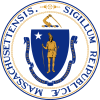| Elections in Massachusetts |
|---|
 |
Massachusetts increased 3 seats to 17 in reapportionment after the 1800 census. Massachusetts law at the time required a majority for election to an office, which requirement was not met in the 6th district , requiring two additional ballots.
Contents
| District | Incumbent | Party | First elected | Result | Candidates [Note 1] |
|---|---|---|---|---|---|
| Massachusetts 1 "Suffolk district" | William Eustis Redistricted from the 8th district | Democratic-Republican | 1800 | Incumbent re-elected. | √ William Eustis (Democratic-Republican) 50.8% [1] John Quincy Adams (Federalist) 49.2% |
| Massachusetts 2 "Essex South district" | Nathan Read Redistricted from the 10th district | Federalist | 1800 (Special) | Incumbent retired. New member elected. Democratic-Republican gain. | √ Jacob Crowninshield (Democratic-Republican) 51.9% [2] Timothy Pickering (Federalist) 48.0% |
| Massachusetts 3 "Essex North district" | Manasseh Cutler Redistricted from the 11th district | Federalist | 1800 | Incumbent re-elected. | √ Manasseh Cutler (Federalist) 75.5% [3] Thomas Kitteridge (Democratic-Republican) 21.4% Others 3.1% |
| Massachusetts 4 "Middlesex district" | Joseph Bradley Varnum Redistricted from the 9th district | Democratic-Republican | 1795 | Incumbent re-elected. | √ Joseph Bradley Varnum (Democratic-Republican) 70.1% [4] Timothy Bigelow (Federalist) 27.7% Samuel Kendall (Federalist) 1.8% |
| Massachusetts 5 "Hampshire South district" | William Shepard Redistricted from the 2nd district | Federalist | 1797 | Incumbent retired. New member elected. Federalist hold. | √ Thomas Dwight (Federalist) 78.0% [5] Samuel Fowler (Democratic-Republican) 9.5% Jonathan Smith (Democratic-Republican) 5.8% Scattering 6.7% |
| Massachusetts 6 "Hampshire North district" | Ebenezer Mattoon Redistricted from the 3rd district | Federalist | 1800 (Special) | Incumbent retired. New member elected. Federalist hold. | First ballot (November 1, 1802): [6] Hugh McClallan (Federalist) 29.5% John Williams (Federalist) 15.2% Samuel Taggart (Federalist) 14.9% Solomon Snead (Democratic-Republican) 12.3% Joseph Lyman (Federalist) 10.1% Solomon Nose (Federalist) 8.0% Edward Upham (Democratic-Republican) 5.2% Zebina Montague 4.8% Second ballot (January 24, 1803): [7] Hugh McClallan (Federalist) 36.9% Samuel Taggart (Federalist) 27.5% Solomon Snead (Democratic-Republican) 21.2% John Williams (Federalist) 14.4% Third ballot (April 3, 1803): [8] √ Samuel Taggart (Federalist) 73.2% Hugh McClallan (Federalist) 26.8% |
| Massachusetts 7 "Plymouth district" | Josiah Smith Redistricted from the 6th district | Democratic-Republican | 1801 | Incumbent retired. New member elected. Federalist gain. | √ Nahum Mitchell (Federalist) 58.3% [9] Henry Warren (Democratic-Republican) 41.6% |
| Massachusetts 8 "Barnstable district" | Lemuel Williams Redistricted from the 5th district | Federalist | 1799 | Incumbent re-elected. | √ Lemuel Williams (Federalist) 55.5% [10] Isaiah L. Green (Democratic-Republican) 44.5% |
| Massachusetts 9 "Bristol district" | Phanuel Bishop Redistricted from the 7th district | Democratic-Republican | 1799 | Incumbent re-elected. | √ Phanuel Bishop (Democratic-Republican) 57.3% [11] Laban Wheaton (Federalist) 42.4% |
| Massachusetts 10 "Worcester South district" | Seth Hastings Redistricted from the 4th district | Federalist | 1801 (Special) | Incumbent re-elected. | √ Seth Hastings (Federalist) 62.2% [12] Edward Bangs (Democratic-Republican) 37.3% |
| Massachusetts 11 "Worcester North district" | None (District created) | New seat. New member elected. Federalist gain. | √ William Stedman (Federalist) 71.7% [13] John Whiting (Democratic-Republican) 27.9% | ||
| Massachusetts 12 "Berkshire district" | John Bacon Redistricted from the 1st district | Democratic-Republican | 1801 | Incumbent retired. New member elected. Democratic-Republican hold. | √ Thomson J. Skinner (Democratic-Republican) 58.4% [14] Daniel Dewey (Federalist) 41.0% |
| Massachusetts 13 "Norfolk district" | None (District created) | New seat. New member elected. Democratic-Republican gain. | √ Ebenezer Seaver (Democratic-Republican) 65.1% [15] Oliver N. Everett (Federalist) 29.4% Samuel Dexter (Democratic-Republican) 2.8% Benjamin Hitchbourne (Democratic-Republican) 2.8% | ||
| Massachusetts 14 "York district," District of Maine | Richard Cutts | Democratic-Republican | 1801 (Special) | Incumbent re-elected. | √ Richard Cutts (Democratic-Republican) 52.3% [16] John Lord (Federalist) 44.4% Moses Sweat (Federalist) 3.2% |
| Massachusetts 15 "Cumberland district," District of Maine | Peleg Wadsworth Redistricted from the 13th district | Federalist | 1793 | Incumbent re-elected. | √ Peleg Wadsworth (Federalist) 88.5% [17] Isaac Parsons 8.5% Scattering 3.0% |
| Massachusetts 16 "Lincoln district," District of Maine | Samuel Thatcher Redistricted from the 12th district | Federalist | 1802 (Special) | Incumbent re-elected. | √ Samuel Thatcher (Federalist) 63.7% [18] William King (Democratic-Republican) 18.1% John Farley (Democratic-Republican) 12.7% Scattering 5.5% |
| Massachusetts 17 "Kennebec district," District of Maine | None (District created) | New seat. New member elected. Federalist gain. | √ Phineas Bruce (Federalist) 57.5% [19] Martin Kinsley (Democratic-Republican) 42.5% | ||